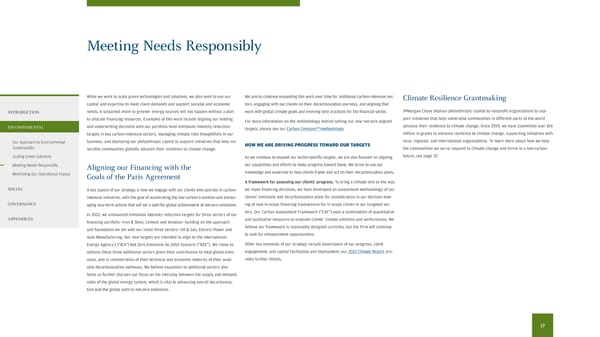Meeting Needs Responsibly While we work to scale green technologies and solutions, we also seek to use our We aim to continue expanding this work over time for additional carbon-intensive sec- Climate Resilience Grantmaking capital and expertise to meet client demands and support societal and economic tors, engaging with our clients on their decarbonization journeys, and aligning that INTRODUCTION needs. A sustained move to greener energy sources will not happen without a plan work with global climate goals and evolving best practices for the fnancial sector. JPMorgan Chase deploys philanthropic capital to nonproft organizations to sup- port initiatives that help vulnerable communities in diferent parts of the world to allocate fnancing resources. Examples of this work include aligning our lending For more information on the methodology behind setting our new net-zero aligned advance their resilience to climate change. Since 2019, we have committed over $16 ENVIRONMENTAL and underwriting decisions with our portfolio-level emissions intensity reduction targets, please see our Carbon CompassSM methodology. million in grants to advance resilience to climate change, supporting initiatives with targets in key carbon-intensive sectors, managing climate risks thoughtfully in our local, regional, and international organizations. To learn more about how we help Our Approach to Environmental business, and deploying our philanthropic capital to support initiatives that help vul- HOW WE ARE DRIVING PROGRESS TOWARD OUR TARGETS Sustainability the communities we serve respond to climate change and thrive in a low-carbon nerable communities globally advance their resilience to climate change. Scaling Green Solutions As we continue to expand our sector-specifc targets, we are also focused on aligning future, see page 37. Meeting Needs Responsibly Aligning our Financing with the our capabilities and eforts to make progress toward them. We strive to use our Minimizing Our Operational Impact Goals of the Paris Agreement knowledge and expertise to help clients frame and act on their decarbonization plans. A framework for assessing our clients’ progress. To bring a climate lens to the way SOCIAL A key aspect of our strategy is how we engage with our clients who operate in carbon- we make fnancing decisions, we have developed an assessment methodology of our intensive industries, with the goal of accelerating the low-carbon transition and encour- clients’ emissions and decarbonization plans for consideration in our decision mak- GOVERNANCE aging near-term actions that will set a path for global achievement of net-zero emissions. ing of new in-scope fnancing transactions for in-scope clients in our targeted sec- In 2022, we announced emissions intensity reduction targets for three sectors of our tors. Our Carbon Assessment Framework (“CAF”) uses a combination of quantitative APPENDICES fnancing portfolio—Iron & Steel, Cement and Aviation—building on the approach and qualitative measures to evaluate clients’ climate ambition and performance. We and foundation we set with our initial three sectors—Oil & Gas, Electric Power and believe our framework is reasonably designed currently, but the Firm will continue Auto Manufacturing. Our new targets are intended to align to the International to look for enhancement opportunities. Energy Agency’s (“IEA”) Net Zero Emissions by 2050 Scenario (“NZE”). We chose to Other key elements of our strategy include Governance of our progress, client address these three additional sectors given their contribution to total global emis- engagement, and capital facilitation and deployment; our 2022 Climate Report pro- sions, and in consideration of their technical and economic maturity of their avail- vides further details. able decarbonization pathways. We believe expansion to additional sectors also helps us further sharpen our focus on the interplay between the supply and demand sides of the global energy system, which is vital to advancing overall decarboniza- tion and the global path to net-zero emissions. 17
 2022 Environmental Social Governance Report Page 18 Page 20
2022 Environmental Social Governance Report Page 18 Page 20